3 Types of Gum Disease Treatment

General dentistry has several approaches to gum disease treatment. The goal is to prevent complications like tooth loss, relieve pain and discomfort, and restore the patient’s smile. Learning the basics of the most common types of gum disease treatment can help patients better understand why a specific approach is recommended for their oral health needs.
Understanding gum disease and its oral health impact
Gum problems tend to begin with gingivitis, an early stage of gum disease characterized by gum inflammation, redness, swelling, and occasional bleeding during brushing or flossing. Gingivitis can progress without treatment, eventually damaging the jawbone and tissues that support the teeth. Advanced gum disease can result in tooth mobility and even tooth loss.
Gum disease results from the buildup of plaque and tartar on the teeth, which harbor harmful bacteria that irritate and infect the gums. Risk factors include poor oral hygiene, smoking, hormonal changes, and certain medical conditions. Beyond oral health, untreated gum disease has been linked to systemic issues from heart disease to diabetes, another reason why it is important to treat it promptly.
Types of gum disease treatment
While gingivitis may be reversible with non-invasive procedures, advanced gum disease often requires more intensive interventions. Here are three common types of gum disease treatment commonly recommended in general dentistry:
Deep cleaning: Scaling and root planing
A deep cleaning called scaling and root planing can effectively treat mild to moderate gum disease. This non-invasive treatment involves removing plaque and tartar from above and below the gum line (scaling) and smoothing the root surfaces (root planing) to prevent bacteria from reattaching. Conversely, the gums can easily reattach to smooth, clean teeth roots.
A dentist or dental hygienist may use special instruments, ultrasonic devices, or laser technology to thoroughly clean the affected areas during scaling and root planing. As a result of this procedure, patients often experience reduced gum inflammation, tighter gum attachment, and an improvement in overall gum health.
Antibiotic therapy for gum infections
Antibiotic therapy often works alongside other treatments to target the bacterial infection causing gum disease. Dentists may recommend systemic antibiotics in pill form, as well as local antibiotic gels or dissolvable strips to be applied directly to the affected gum tissue. This gum disease treatment aims to reduce infection, relieve inflammation, and improve gum pocket depth, enhancing the overall efficacy of other treatments.
Surgical gum disease treatments
For advanced gum disease that has caused significant damage to the gum tissue or supporting structures, surgical intervention may be necessary. Surgical gum disease treatments include the following techniques, each of which can address specific issues:
- Flap surgery. Lifts the gums to access and clean deeper pockets of infection.
- Bone grafting. Restores bone density and supports the teeth.
- Soft tissue grafting. Covers exposed tooth roots and restores the gum line.
Surgical treatments are typically reserved for advanced gum disease but can be highly effective in restoring oral health and function.
Schedule a consultation for gum disease treatment
By promptly addressing gum disease with professional gum disease treatment, patients can maintain healthy gums, strong teeth, and overall well-being. Whether the patient has a mild or advanced case of gum disease, there are effective treatments available to restore their oral health. Call our Hollister general dentistry office today to learn more.
Request an appointment here: https://matthewparilladmd.com or call Matthew Parilla DMD at (831) 207-4692 for an appointment in our Hollister office.
Check out what others are saying about our dental services on Yelp: Gum Disease in Hollister, CA.
Related Posts
Dental restorations can help you maintain your oral health and prevent further decay. A dental filling is one of the most common restorative procedures used to treat mild to moderate cavities and other dental damage. This type of restoration restores the function and appearance of a damaged or decayed tooth. Let us walk you through…
A dental bridge is a popular solution to replace one or more missing teeth, restoring the function and appearance of your smile. However, you may be wondering how long a dental bridge will last. While several factors will influence the longevity of the dental bridge, understanding the expected lifespan and necessary care can help you…
Helping your child develop good oral hygiene habits starts at home. But which products should you use to keep their teeth bright and healthy? Our kid-friendly dentist can recommend the best products to support your child's oral healthcare between their routine checkups and cleanings.A soft-bristled toothbrush designed for children is one of the most important…
Sleep apnea is a chronic disorder in which an individual briefly stops breathing while asleep. These breathing interruptions can cause the person to wake up, gasp for air or snore. Left untreated, this condition can lead to sleep deprivation and negatively affect overall health. Many people suffer from this sleep issue without knowing it. It is…
